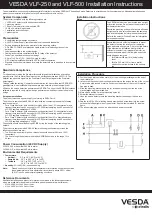
NOTE: If the Test button is pressed and held during the Silence mode, the smoke alarm will be
tested normally. Upon the release of the Test button, the Silence mode will be restarted.
Before using the alarm Silence Feature, identify the source of smoke and be certain that safe
conditions exist.
Clean the smoke alarm at least once a month
to remove dust, dirt, insects or debris. Using a soft
brush or wand attachment to a vacuum cleaner, vacuum all sides and cover of smoke alarm. Be
sure all the vents are free of debris.
If the smoke alarm is false alarming and cannot be restored to normal operation, the smoke alarm
should be replaced.
BATTERY REPLACEMENT
The smoke alarm uses a 9 Volt battery. The battery should last for at least one year under normal
operating conditions. The smoke alarm has a low battery indicator, an audible beep or chirp. It will
operate at approx. 40 second intervals for a minimum of 7 days. When this indication occurs, replace
the battery with an Alkaline type (Energizer #522, Duracell #MN1604) or Lithium type (Ultralife U9VL-
J) from your local retailer.
LITHIUM Battery Models only - The LITHUM battery is warranted to last for 10 years under normal
operating conditions. Replace the battery with only LITHIUM type: (ULTRALIFE: U9VL-J).
Remove the battery. While observing polarity, push the replacement battery into the battery tray until
it is held securely in place.
Test the smoke alarm by pushing the TEST button on the smoke alarm cover until the alarm sounds,
then release.
REPAIRS AND SERVICES
This smoke alarm contains less than 1 microcurie (37 kilobecquerel) of Americium 241, a radioactive
material.
The distribution of these ionization-type smoke alarms is licensed by the U.S. Nuclear
Regulatory Commission; the consumer is exempt from any licensing or requirements.
If the
smoke alarm is defective in any way, do not tamper with the smoke alarm. Return the smoke alarm
for servicing. (See warranty for instructions or in-warranty returns.) There will be a service charge for
repairing out of warranty smoke alarms.
DEVELOP AND PRACTICE A PLAN OF ESCAPE
BASICS OF ESCAPE PLAN
o Make a floor plan indicating all doors and windows and at least two escape routes from each room.
Second story windows may need a rope or chain ladder.
o Have a family meeting and discuss your escape plan, showing everyone what to do in case of fire.
o Determine a place outside your home where all of you can meet if a fire occurs.
o Familiarize everyone with the sound of the smoke alarm and train them to leave your home when
they hear the sound.
o Identify children's bedrooms with red stickers placed in the upper left corner of the windows. They
are available from your local fire department.
o Practice a fire drill at least every six months. Practice allows you to test your plan before an emer-
gency. You may not be able to reach your children. It is important they know what to do!
WHAT TO DO WHEN THE ALARM SOUNDS
o Leave immediately by your plan of escape. Every second counts, so don't waste time getting dressed
or picking up valuables.
o In leaving, don't open any inside door without first feeling its surface. If hot, or if you see smoke
seeping through cracks,
don't open that door!
Instead, use your alternate exit. If inside door is
cool, place your shoulder against it, open it slightly and be ready to slam it shut if heat and smoke
rush in.
o Stay close to the floor if air is smoky. Breathe shallowly through a cloth, wet if possible.
o Once outside, go to your selected meeting place and make sure everyone is there.
o Call the fire department from your neighbor's home –
not from yours!
o Don't return to your home until fire officials say that it is all right to do so.
Page 6



























